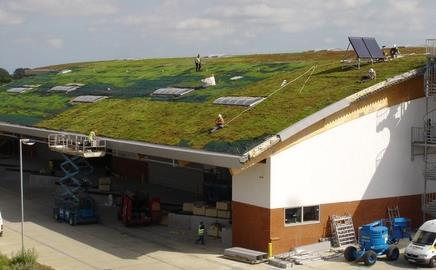Green roofs are a rapidly expanding business for Greenfix. Its managing director, Mike Cottage, explains how they work and why the future is actually brown roofs.
Greenfix, founded in 1998, has a UK turnover of about ┬Ż2m. Green roofs represent a growing part of its business, which also includes soil stabilisation and erosion control. Laid over independent load-bearing structures, these multi-layered roofs contain live organic materials. The companyŌĆÖs 13 employees are based mainly in Cheltenham but the biodegradable materials used for each job are sourced locally, where possible. We speak to managing director Mike Cottage.
The basic ingredients of a green roof, from the top down, are: a pre-grown sedum blanket and a sedum substrate (including soil), which we provide; and a filter fabric and a drainage layer, which we buy in. But there are many variations.
Sedum is a bit like cactus. It stores water in its leaves and is highly durable. It can grow in numerous settings and can go six weeks without water. We also exploit its ability to support all sorts of flora and fauna. But its overriding function is for water absorption, storing and release.
People find us in a number of ways. We have relationships with waterproofing companies who recommend us, and some architects find us directly from adverts or the internet.
Once weŌĆÖve been commissioned, we ask what the customer wants to do with the roof. WeŌĆÖll then work together to find a solution. Sometimes architectural specifications can be very detailed; sometimes weŌĆÖll talk to a client who has no concept at all and weŌĆÖll help them come up with a design. In all cases, weŌĆÖll get involved very early on and weŌĆÖll do all the relevant calculations, including those for substrate and drainage. The architect might ask for significant changes, which weŌĆÖre usually able to accommodate. Value engineering might come into the equation, as cost is a primary concern but itŌĆÖs unusual for customers to suggest different suppliersŌĆÖ components. ItŌĆÖs not unknown, though, and it can be handy if weŌĆÖre led to a good new supplier.
Once weŌĆÖre ready to go on site, we can be there for anything from three days to three months. The size of area to be covered is the biggest determining factor. The green roof arrives in different components. Some of it comes in panels, the substrate is in bags and the sedum blanket comes in rolls. All of it can be easily handled, which is important when working at height. Although itŌĆÖs light enough to carry up ladders and scaffolding, weŌĆÖll often use cranes and hoists.
One of our most technically challenging contracts was the AdnamŌĆÖs brewery at Southwold in Suffolk, which was worth ┬Ż200,000 to us, and was incorporated onto a metal standing-seam roof. We had to work at the height of summer. We didnŌĆÖt envisage the extremes of hot weather. This was a problem because live materials in heat can suffer after theyŌĆÖve been uprooted and transported from one environment to another. We had to replace some material.
WeŌĆÖre just about to start work on a large roof for developer Berkeley First in Isleworth, west London. Taylor Woodrow is the main contractor and it made contact with us through an architect. The project is for a block of flats and will include decking, paths, trees and a more durable layer to cope with the extra loading.
Postscript
For a full guide to roofing suppliers, log on to
Topics
Specifier 1 June 2007
- 1
- 2
- 3
- 4
- 5
- 6
 Currently reading
Currently readingGrowth spurt
- 7
- 8
- 9
- 10
- 11
- 12
- 13
- 14

































No comments yet